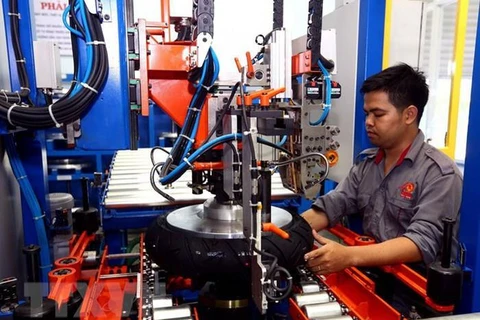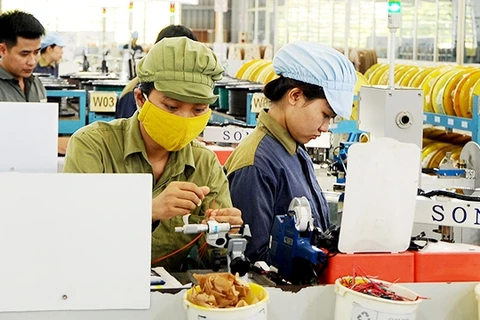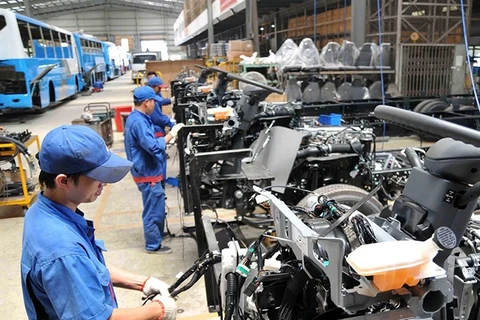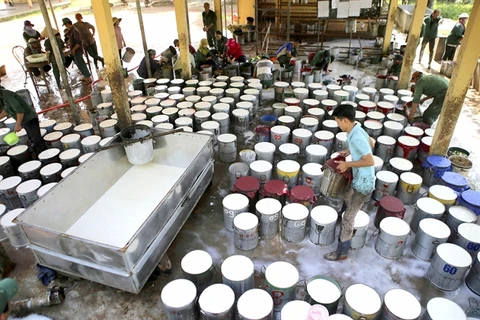 Production at Son Nam Textile and Garment Joint Stock Company in Nam Dinh province. The COVID-19 pandemic which causes disruptions in global supply chains is urging policies to push the development of the supplying industries (Photo: VNA)
Production at Son Nam Textile and Garment Joint Stock Company in Nam Dinh province. The COVID-19 pandemic which causes disruptions in global supply chains is urging policies to push the development of the supplying industries (Photo: VNA) Vietnam’s part-supply industries remained weak in terms of technology, management capacity and linkages with foreign-direct-investment (FDI) companies, which became evident when the COVID-19 pandemic caused disruptions to global supply chains.
The recent virus outbreaks at industrial parks pushed many enterprises into difficulty with a severe shortage of components and materials for production.
Automobile manufacturer Huyndai Thanh Cong said that the company was facing a chip shortage and planned to reduce 20 percent of their production capacity. They said that risks of further cuts in production existed if the chip crunch did not ease.
Nguyen Van Ket, director of mechanics company SKD Vietnam, said that his company was also affected by the shortage of chips which depends on imported sources.
The shortage of components and materials for production has become more severe during the outbreak of the COVID-19 pandemic in a number of countries which makes transportation of goods more difficult.
According to Truong Thi Chi Binh, Deputy President of the Vietnam Association for Supporting Industries, although production was maintained during the pandemic, nearly 50 percent of the association's member enterprises saw drops in revenue.
Vietnam’s supporting enterprises remained of weak capacity compared with other countries in the region such as Thailand, Indonesia, Malaysia and India, which made Vietnamese enterprises more vulnerable to global shocks and disruptions to value chains.
A report from the Ministry of Industry and Trade showed that for the garment and textile industry, as an example, the local procurement rate was just 40-45 percent and the industry has to depend on imported fabric. The industry mainly did outsourcing contracts with a low added value.
For the automobile production industry, the local procurement rate was far below what was expected.
The local procurement rate for the electronics and telecommunications industry was only around 15 percent and just five percent for hi-tech industries.
Dao Phan Long, President of the Vietnam Association of Mechanical Industry, said Vietnam lacked spearhead products which could compete with imported ones. In addition, the country remained largely dependent on imports of raw materials for production, which would also undermine its productivity and competitiveness.
More than ever, enterprises need further support from the Government to recover production and promote the development of the part-supply industry, Binh said.
She said that policies should be developed to encourage the consumption of domestically-produced products and expand exports.
A law supporting industries is important to attract investment and promote the development of these industries.
According to the Industry Agency under the Ministry of Industry and Trade, the ministry will study and develop policies to attract investment and enhance linkages to promote technology transfers between FDI and domestic enterprises. This would contribute to support the development of the part-supply industries.
The ministry’s database of the manufacturing and processing industry included more than 3,600 potential enterprises operating in mechanical, automotive, electronics, footwear, and garment and textile industries.
Vietnam set the target of having at least 1,000 enterprises that are capable of being direct suppliers to multinational companies./.
VNA
























